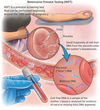13 - Mutations Flashcards
(50 cards)
What is a mutation and what is mutagenesis?
Mutation - A change in the nucleotide sequence
Mutagenesis - Process of mutation generation
What is deanimation mutation?
Removal of an amino group from a molecule causing a change in base

What are some DNA level mutations and how do they occur?
- Exogenous sources (radiation, free radicals etc)
- Endogenous sources (transposable elements, replication defects)
- Spontaneously

Why does spontaneous deanimation always result in a mutation?

What are transposons?
- Sit within chromosome
- Greater length than one gene
- Can move as discrete unit and insert themselves into another location (transposition)
- Issue if inserted into genes as can cause non-functional polypeptide, inactive/activate gene
- Bigger the gene bigger the risk of transposition, e.g DMD

What is a SNiP?
Single nucleotide polymorphism
- Where one nucleotide is different to the rest of the population
- Anonymous SNP, coding SNP, non-coding SNP (not in gene)

What are micro mutations?

What are the two types of substitution?
Transition - Same base for same base
Transversion - Change to different base (pyramidine to purine)
What can a single nucleotide change result in?
- No effect
- Change polypeptide length
- Change amount of product
- Change gene product
What is the genetics behind sickle cell anaemia?
- Autosomal recessive
- Base substitution in codon 7 of HBB, changing 6th AA

What is a non-sense mutation?
Mutation causes a change in the stop codon so it is not recognised so polypeptide longer than should be
What is a missense mutation?
Mutation that results in a different amino acid being coded for
What is a synonymous mutation?
Substitution, same amino acid coded for. (could be due to wobble)
What is a frameshift mutation?
When there is a change in the number of nucleotides, not in the multiple of 3, so all the amino acids downstream are different
Why might a deletion of three bases not cause any affect, and why may it cause a drastic effect?
- No frameshift so only one amino acid missing
- If amino acid usually located in active site will cause non-functional protein but if not, not much difference to overall structure of protein
What is haemoglobin wayne and haemoglobin CS?
- Normal alpha Hb: 141 aa
- alpha wayne: 147 aa (deletion of A at 139 causing frameshift so stop codon not read)
- alpha cs: 172aa (substitution in 142 stop codon so not read)
NON-SENSE MUTATIONS

How could a mutation lead to a change in the amount of a gene product?
- Mutation in regulatory sequence
- Alter promoter activity
- Prevent mRNA splicing (splicing sites change)
- Reduce mRNA stability (mutations in tails and caps)
- Earlier start codon
What are haemoglobin lyon and leiden?
- Leiden: Loss of Glu at 6
- Lyon: Loss of Lys and Val at 17/18
What are the types of chromosome mutation?
- Translocation (reciprocal/robertsonian)
- Inversion (para/pericentric)
- Duplication
- Substitution
- Deletion

What are the two types of chromosome inversion?
Paracentric: on one side of the centromere, within one arm
Pericentric: inversion occurs over the centromere
What happens during chromosome substitution (insertion)?
One part of a chromosome is moved from one chromosome to another

What are the two types of protein translocation?
Reciprocal: Swapping of genetic material
Robertsonian: Breaking at the centromere on two acrocentric chromosomes. Lose the p arms, two q-arms fuse. Individual has 45 chromosomes

Apart from the main chromosome mutations, what are three other structural mutations that can occur?
- Ring chromosomes (end break and fuse to ring)
- Isochromosomes (two p together, abnormal centromere split)
- Marker chromosomes (small fragements of chromosomes)

What is polyploidy?
- more than two sets of homologous chromosomes (3n=69)
- usually due to polyspermy
- triploidy occurs in 2-3% of pregnancies and causes 15% of miscarriages
















